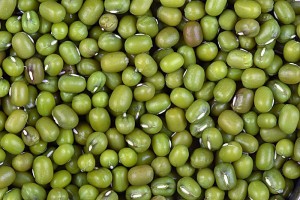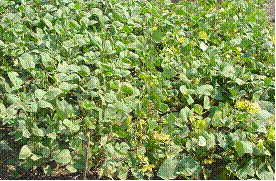 The mungbean (Vigna radiata L.), popularly known as Mongo or Munggo in the Philippines, are small green legumes grown widely for use as a human food (as dry beans or fresh sprouts), but can be used as a green manure crop and as forage for livestock. It is the main ingredient of the dessert hopiang munggo, and also a savory soup called ginisang munggo in our country. They are generally eaten either whole (with or without skins) or as bean sprouts, whole mung beans are generally prepared from dried beans by boiling until they are soft.
The mungbean (Vigna radiata L.), popularly known as Mongo or Munggo in the Philippines, are small green legumes grown widely for use as a human food (as dry beans or fresh sprouts), but can be used as a green manure crop and as forage for livestock. It is the main ingredient of the dessert hopiang munggo, and also a savory soup called ginisang munggo in our country. They are generally eaten either whole (with or without skins) or as bean sprouts, whole mung beans are generally prepared from dried beans by boiling until they are soft.
Mung beans are a popular alternative to meat for vegetarians and those on strict budgets since they pack a lot of protein for the price. Mung beans are also quite high in potassium, fiber, magnesium and B vitamins. They also make an excellent diet food since one cup (250 ml) of mung beans is less than 30 calories.
Mung beans are tropical (or sub-tropical) crops, and require warm temperatures (optimally around 30-35°C). They are warm season annuals, highly branched and having trifoliate leaves like the other legumes. Both upright and vine types of growth habit occur in mungbean, with plants varying from one to five feet in length. The pale yellow flowers are borne in clusters of 12–15 near the top of the plant. Mature pods are variable in color (yellowish-brown to black), about five inches long, and contain 10 to 15 seeds. Self pollination occurs so insect and wind are not required. Mature seed colors can be yellow, brown, mottled black or green, depending upon variety. These round to oblong seeds vary in size from 6,000 to over 12,000 per pound, depending upon variety.
Production of Mongo (Mungbean)
Uses
- It is a raw material in th major processes namely: mungbean sprout production; sotanghon manufacturing; hopia processing; dishes like soups, porridge, snacks, bread, noodles and ice cream.
- Mungbean starch is extensively used for starch noodles.
- Mungbean protein is used to fortify cereal flour.
- Crop residues are used for fodder.
- It is also grown for hay, green manure or cover crop.
Climatic Requirement
Mungbean is drought-tolerant and requires a warm climate during its growing period. The prevailing temperature and humidity in the region is suited for optimum yields.
Recommended Varieties
- BPI Mg 9
- Pag-asa 7
- NSIC Mg 8
- NSIC Mg 12
- NSIC Mg 13
- Other all-season varieties

Planting
1. Just after harvesting rice:
- Flush irrigate the area and drain excess water
2. Broadcast evenly the mungo seeds at the rate of:
- 30 kgs seeds/ha (90-95% germination)
- 35 kgs seeds/ha (80-85% germination)
- 37-40 seeds/ha (75-80% germination)
3. If rice stubbles is 10-15 cm high, lightly puddle with mini tractor-drawn the area to help seeds in the stubbles get in contact with the soil.
Seed Inoculation
- Inoculate the seeds prior to broadcasting with rhizobium inoculant at the rate of 5 kgs/pack of inoculant.
- To inoculate the seeds; a) sprinkle/moisten the seeds with water (10 kgs:1 glass of water).
- Pour the inoculants and mix evenly until seeds are well-coated.
- Broadcast the inoculated seeds just after mixing.
Nutrient Management
- To ensure high yield and attain 3 pod priming frequency, spray the plants with foliar fertilizer (high in potassium and phosphorous content) at 25-30 DAP and after 1st and 2nd priming.
- Foliar fertilizer spraying can be combined/mixed with compatible insecticides.
Pest Management
- 3-5 days after seed emergence, spray the plants with appropriate insecticides to control beanfly (wilting and presence of pin-holes in leaves at seedling stage are common symptoms)
- If high population of weeds (particularly grass) are outgrowing the plants, spray selective post-emergence herbicide like ONECIDE.
- Control leaf folder and pod borer by spraying contact insecticide at vegetative stage (10-15 days after planting (DAP), flowering stage (20-30 DAP) and every after pod priming.
- Control powdery mildew and Cercospora leaf spot disease with appropriate fungicides starting flowering stage.
- Rogue/uproot and burn mosaic-infected plants to avoid spread of virus diseases.
Harvest Management
- Handpicking (or priming) mature (black) pods in the early morning or late afternoon to minimize shattering
- Priming is done up to five times depending on the maturity of the pods. In some part of Pampanga, the farmers cut the plants at one time when most of the pods have matured. Attain three primings and harvest at 1-week interval
Sun-drying & Threshing
Freshly harvested pods are sundried on concrete pavement or on the ground with mat; pods are threshed by beating or trampling on dried pods. Manual threshing can be done but the use of mechanical rice-thresher can speed- up the operation and reduce expenses
Cleaning
It is done by sieving or winnowing the threshed pods.
Storage
- Use of nylon or jute sacks, cans (covered air-tight) and empty cement sacks and stored inside the house or storehouse.
- Cool overnight the seeds before keeping in a storage cans.
- Mix the seeds with dried neem tree seeds/leaves, hot pepper (siling labuyo), naphthalene balls, etc.
Sources: www.bar.gov.ph; Photos: Wikimedia